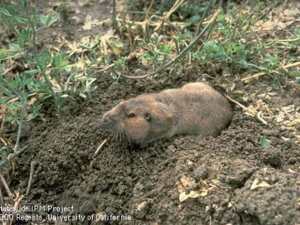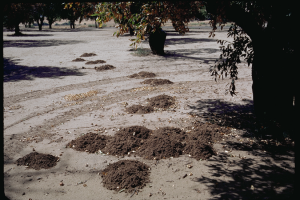Roger A. Baldwin, UCCE Wildlife Specialist, Wildlife, Fish, & Conservation Biology, UC Davis and Joseph Connell, UCCE Farm Advisor Emeritus, Butte County
Pocket gophers (Thomomys spp.) may be responsible for more damage to orchards than any other mammal species. It’s essential to minimize their presence in orchards and this is particularly important for young trees that are highly susceptible to gopher damage. Since reproduction increases toward late winter through early spring, control is more effective before this reproductive pulse since there are fewer individuals to remove. When soil moisture is high, gophers make mounds frequently, easing identification of active tunnel systems, and thus reducing the time required to treat the orchard. Gopher control programs include trapping, burrow fumigants, and toxic baits.

Pocket gopher at his burrow entrance. They might be cute, if they weren’t so destructive. Photo credit: UC Statewide IPM Program.
Trapping is safe and one of the most effective methods for controlling gophers. Recent studies have shown a 90% reduction in gopher density after two trapping sessions separated by 1 to 2 weeks. A third trapping session has resulted in complete removal of pocket gophers from some fields. Trapping is a tool all growers should employ to some extent, even if it is not the preferred primary approach. Trapping can be a good follow-up approach since it allows you to target remaining individuals other tools have missed.
Fumigation with aluminum phosphide is the most effective fumigant for gopher control (around 90% control after two treatment periods) and it has a low material cost, although labor costs can be higher. Find the gopher’s main tunnel with a probe and drop the label designated number of tablets into the probe hole. Seal the opening to keep light from entering and toxic gases from escaping. Treat each active burrow system twice to maximize efficacy. Only apply aluminum phosphide treatments when soil moisture is relatively high; the most effective timing is in late winter and early spring. Aluminum phosphide is a restricted-use material so applicators must be licensed and trained on its proper use.
Acute toxicant baits such as strychnine-treated grain bait kills after a single feeding and is available at a 0.5% concentration in California. Recent investigations have shown 0.5% strychnine is still highly effective, with 100% removal rates observed in trials. When repeatedly used over time, gophers can develop behavioral resistance to strychnine. So, be sure to supplement baiting with other management approaches to reduce this potential. Proper application is essential for effective control.
Hand baiting with an all-in-one probe and bait dispenser can be effective if you have relatively few gophers in a field. Once the tunnel is located, bait is directly deposited via a hand-crank or lever. Treat each burrow system at least twice to maximize efficacy.
A burrow builder pulled behind a tractor that creates an artificial burrow is a more practical method for treating larger areas. Gophers will come across these artificial burrows and consume bait that has been deposited at set intervals within the artificial burrow. Soil moisture must be just right; if too dry, the artificial burrow will cave in, if too wet, the burrow will not seal properly allowing light to filter in thus preventing gophers from travelling down the burrow. Efficacy varies greatly depending on how well you implement the method.

Whichever method of control you choose, you’re going to have to do something about those gopher mounds! Photo credit: UC Statewide IPM Program.
In summary, all techniques require multiple applications to maximize control. Management must be integrated since continued reliance on only one technique results in lower efficacy as gophers adapt to avoid control (e.g., strychnine behavioral resistance). Recognize that re-invasion into orchards will occur. Regular long-term monitoring and removal of invaders before they multiply and re-establish is just part of good orchard management. For additional information on managing gophers, check out the UC IPM Pocket Gopher Pest Note.


Leave a Reply